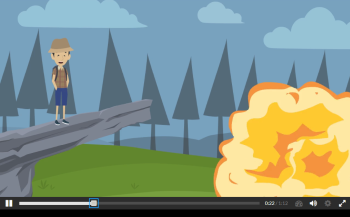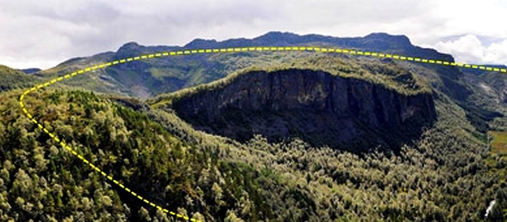In Norway, we know of three meteorite craters. In Sweden they have found 8 and in Finland 12. Researchers at the Department of Geosciences have developed a free online mini-course for teachers, pupils and the public: to learn, find, describe and report structures in the Norwegian landscape. Are there more Norwegian craters?
Become an "expert" on craters by taking the mini-course “Large, round structures in Norwegian nature”. A new online knowledge resource developed by researchers at the Department of Geosciences. The picture/illustration is from the introductory part of the course.
As of October 2019, 191 craters have been found on Earth. In Norway, we have three impact craters that can tell of meteorites that once hit the Earth. What minerals and elements did they consist of? How were they reshaped at impact, and did they affect where they struck?
Those interested can learn about meteorite craters and impact structures in the online, free and open to all new knowledge resource; “Large, round structures in Norwegian nature”, developed by Henning Dypvik, Thor Thorsen and Svein Olav Krøgli., This resource can be used in the teaching of natural science and geosciences. The resource is available Norwegian.
¬ From the summer of 2020, it will also be included in a learning plan for the Gardnos Meteorite Park (Nesbyen), says Henning Dypvik. Professor at the Department of Geosciences.
Craters are round structures in the landscape

Most of the meteorite impacts have something in common; they often leave round structures in the impact field, bowl-shaped structures that can be several km wide and many 100 meters deep.
Some craters are huge, for example:
For 65.5 million years ago, on the transition between the geological periods of Cretaceous and Paleogene, the dinosaurs died out. From this time period, evidence of a meteorite impact has been found: The Chicxulub crater in the Gulf of Mexico. This round structure is enormous, 150 km in diameter.
Norway has three known craters
The violent forces that strikes when the meteorite hit the crust, forms the meteorite crater. The largest of Norway's three craters is found on the seabed in the Barents Sea - the Mjølnir crater, 40 km wide and 142 million years old.
- The collision with the seabed has been calculated for energy corresponding with that of 400,000 mega tons of TNT, or an 8.3 earthquake on the Richter's scale.explains.
In addition to Mjølnir we have the Gardnos structure at Nesbyen in Hallingdal around 546 million years old. Norway's oldest crater. . The Norway's last discovered crater, the Ritland crater in Hjelmeland municipality, Rogaland, 2.7 kilometers wide and around 500 million years old.

Are there more?
Professor Dypvik and co-workers are pioneers in research on Norwegian meteorite craters, and are very interested in finding out if there are other craters around Norway's rural areas.
The last module in the web course describes what to look for when examining more closely a circular structure you have found in the landscape.
The knowledge resource consists of 5 interactive modules, with films, facts and questions. Points are given along the way. As a pupil it is popular that after completing the course you will get a diploma. The course takes about an hour to complete.
Development of the knowledge resource has been done in collaboration with Cerpus AS, and has received support from the Akademiaavtalen.
To learn more:
Go to the learning resource (in Norwegian only): Store, runde strukturer i norsk natur
